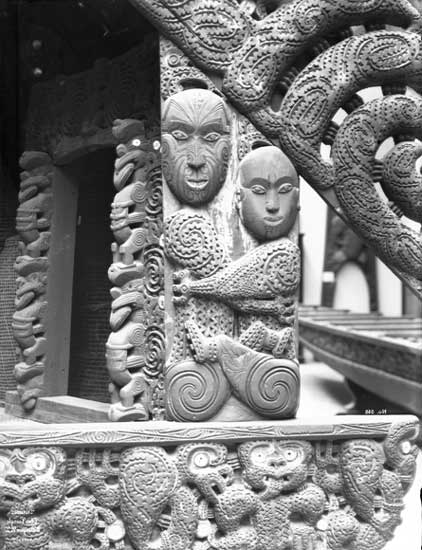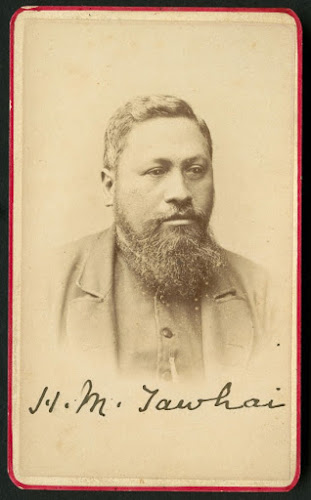On Tribalism and Democracy
In a recent comment piece in the New Zealand Herald, Elizabeth Rata
argued that tribalism and democracy ‘are incompatible — they cannot exist
together as political systems in the one nation’. Tribalism, she further
argued, was premised ‘on principles of inequality’, since kin status was what
mattered. If chieftainship still exists to be expressed, Rata argued, then ‘so
too must the tribal political system of 1840 also exist.’
Morgan Godfery has written a careful reply
to Rata’s piece on his Maui Street Blog. But I want to comment further on Rata’s
argument that tribalism and democracy are mutually incompatible. Historical
Maori leadership structures have always fascinated me. My first
book, published back in 1998, was on the role of committees in the administration
of Maori affairs (Agents of Autonomy:
Maori Committees in the Nineteenth Century). Later I wrote a PhD thesis at
Victoria University of Wellington on a similar topic (‘Runanga and Komiti:
Maori Institutions of Self-Government in the Nineteenth Century’). Since then I
have published several articles on similar themes. Hence my interest in Rata’s
comments.
Firstly, let’s look at British-style
‘democracy’ as at 1840. According to the most recent scholarly estimate I could
find, following the Reform Act of 1832 an estimated 18% of British males over
the age of 21 years were eligible to vote (see Clyve Jones, ed., A Short History of Parliament: England,
Great Britain, the United Kingdom, Ireland and Scotland, Boydell Press,
2012, p. 262). British women did not
gain the franchise until 1918, so in 1840 roughly 9% of the adult population
were entitled to vote. Most people probably would not equate a system that
excluded 91% of the population from participating with a modern-style
democracy. That seems important to bear in mind in any comparison of Maori and
British leadership structures at the time of the Treaty of Waitangi.
Well, what was the nature of Maori
political structures at 1840? To begin with, as most commentators now agree, it
was the hapu rather than the iwi that constituted the primary political entity
(though iwi-level organisation later increased in response to the pressures of
colonisation). Secondly, as I have argued elsewhere, many early European observers
perceived Maori society in hierarchical terms – much like the highly
class-bound communities from which they themselves had come – and viewed the
authority of the chiefs as absolute. I’ll include here an extract from an
article I published in 2011 on this topic (click on this link for the fully
referenced version):
John Savage, who after visiting the north of New Zealand in 1805 authored the first work focused solely on the country, described the form of government he observed at the Bay of Islands to be ‘aristocratical, and hereditary’. John Nicholas similarly concluded in his 1817 account of a visit to the islands that ‘[t]he power of the chiefs...is in general absolute’, though he added that ‘in some districts it is restrained by certain limitations, and controuled [sic] in a great measure by public opinion.’ This qualification was more general than Nicholas appreciated. At least some early European observers came close to appreciating the point. Richard Cruise, who visited New Zealand just a few years later, noted that whilst at Hauraki he had encountered ‘a person bearing the title of areekee...who was said to exert a very despotic control over many of the neighbouring chiefs’ but that ‘in the intercourse he maintained with his countrymen, no more respect or distinction was paid to him than to any other chief.’ The missionary Samuel Marsden noted during his first visit to New Zealand in 1814 that ‘there appears to be no middle class of people in New Zealand...they are all either chiefs or, in a certain degree, slaves. At the same time, the chiefs do not give their commands to the people indiscriminately as a body with that authority which masters, in civil life, exercise over their servants, nor do their dependents feel themselves bound to obey such commands.’Frederick Maning, the author of the classic work Old New Zealand, observed that ‘the natives are so self-possessed, opinionated, and republican, that the chiefs have at ordinary times but little control over them, except in very rare cases, where the chief happens to possess a singular vigour of character, or some other unusual advantage, to enable him to keep them under’. Later observers agreed with these assessments. According to Francis Dart Fenton, writing in 1857:No system of government that the world ever saw can be more democratic than that of the Maoris. The chief alone has no power. The whole tribe deliberate on every subject, not only politically on such as are of public interest, but even judicially they hold their “komitis” on every private quarrel. In ordinary times the vox populi determines every matter, both internal and external. The system is a pure pantocracy, and no individual enjoys influence or exercises power, unless it originates with the mass and is expressly or tacitly conferred by them.Although Fenton and other commentators suggested that rangatira could be accorded large powers during times of war, this applied no more widely than to their own hapu. George Clarke, a member of the Church Missionary Society, concluded that ‘a New Zealander in the field of battle is the most ungovernable creature immaginable [sic] for though a Soldier he is quite independent and if he likes he will obey the voice of his leader or he will not’. To the extent that Hongi Hika led any taua, or war party, it was largely a matter of persuasion, reputation, force of personality, and by personal example, rather than in accordance with any recognised authority. The rangatira himself informed Marsden that whilst at war ‘he was feared and respected, but when he was at home they would not hearken to anything he might say’. Henry Williams, in response to a query as to why one war party had not kept a closer former, was informed that ‘it was their usual way for each party to go where they liked, that every one was his own chief. Without any one to direct, not only does each tribe act distinct from the other, but each individual has the same liberty. If one be bent on mischief, he cannot be restrained by the others.’Rangatira, in short, had great influence over their hapu, but little actual authority beyond that conferred on them by the wider community to implement the will of the group. As Angela Ballara notes, decision-making was ‘a matter of discussion, compromise, and consensus...[which] almost always – save in the case of slaves or client hapu – called for the voluntary assent of the persuaded rather than obedience to any authority’. If there was an incentive to take the word of the chief seriously it lay in the fact that the rangatira was considered the personal embodiment of the mana of the hapu. His misfortunes and reversals would be shared by the wider community and this often created a good reason for both chiefs and their communities to co-operate.
So through mechanisms such as regular hui,
tribal councils and committees, Maori leadership structures were highly
participatory and responsive. Some European observers considered them rather too democratic. It is noteworthy in this
respect that women (and even children) were able to participate in these
processes. John Gorst wrote in rather scathing terms with reference to runanga
that:
The name ‘runanga’ was used by the Maories to denote assemblies of a particular kind, which were in use before ever Europeans came into the country. The Runanga was a sort of council of war, held in war time to discuss war questions. It was formed of the highest chiefs, but inferior men were not excluded, though the reverence then paid to the chiefs forbad the rest to take any prominent part in the discussions. As time went on the Runanga began to take notice of other matters, and to grow more and more democratic, until it degenerated into a promiscuous gathering of men, women, and children, which usurped the whole legislative and judicial function of government.
Joel Polack,
writing of the pre-Treaty period, stated that Maori women took ‘an active
concern in all business of life. They are consulted alike in public and
domestic affairs...and even join the war council, which they at periods aid by
their deliberations.’
I could
go on (at length) with many more examples and much more evidence. But I think I
have made my point: the assumption that Maori society at 1840 was necessarily undemocratic
is not grounded in historical fact (that is, if we are concerned with the substance
of democracy, rather than merely its form). Probably a better case could be
constructed for the undemocratic nature of British government at that time. In
this respect, whatever merit there may be in Elizabeth Rata’s other arguments,
her juxtaposition of tribalism versus democracy is fundamentally flawed.



Nice article, thanks for the information.
ReplyDelete